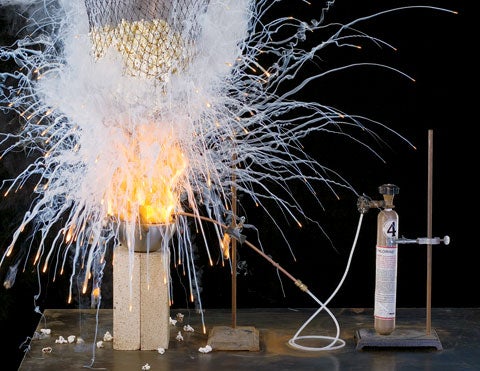Gray Matter: Making salt the hard way
Sodium + chlorine = your favorite popcorn condiment. (And lots of smoke and fire!)

Sodium is a soft, silvery metal that explodes violently on contact with water and burns skin by reacting with even the slightest moisture. Chlorine is a choking yellow gas, used with mixed success in the trenches of World War I (it was known to have killed about equal numbers on both sides of the trench). When these chemicals meet, they react in a fierce ball of spitting fire and clouds of white smoke. The smoke is sodium chloride (NaCl), or table salt, which I used to season a basket of popcorn I hung over the reaction.
- Project: creating a salt cloud
- Cost: $500
- Time: 2 hours
- Difficulty: safe | | | | | crazy (Editor’s note: 5/5)
In the periodic table, as in politics, the unstable elements tend to hang out at the far left and the far right. Sodium is a loose-electron element from the first column (left side) of the table; its extra electron makes it unstable. On the other side of the table is chlorine, an equally volatile one-electron-short-of-a-full-deck element from the far-right 17th column. By transferring sodium’s excess electron to chorine’s nearly full shell, the elements reach a stable configuration in NaCl. Salt doesn’t burn your skin or choke your lungs because, by combining with each other, both elements have scratched their itch.
Achtung! Theodore Gray is a scientist trained in lab safety procedures. Do not attempt this experiment at home. For more information on Gray’s scientific pursuits, visit his website.
As a way of salting popcorn, though, this kind of salt synthesis is pretty out there. The salt is very fresh, but the hazards of blowing pure chlorine into a bowl of liquid sodium are very real. Seconds after this picture was taken, the net melted, dropping popcorn into the bowl and sending a shower of flaming liquid sodium balls in all directions [see video below]. No one was hurt because I’d made safety preparations for even the worst-case scenario, which this nearly was—only an uncontrolled chlorine leak would have been worse, in which case I had a clear path to run like hell.







This story has been updated. It was originally featured in the October 2006 issue of Popular Science magazine.